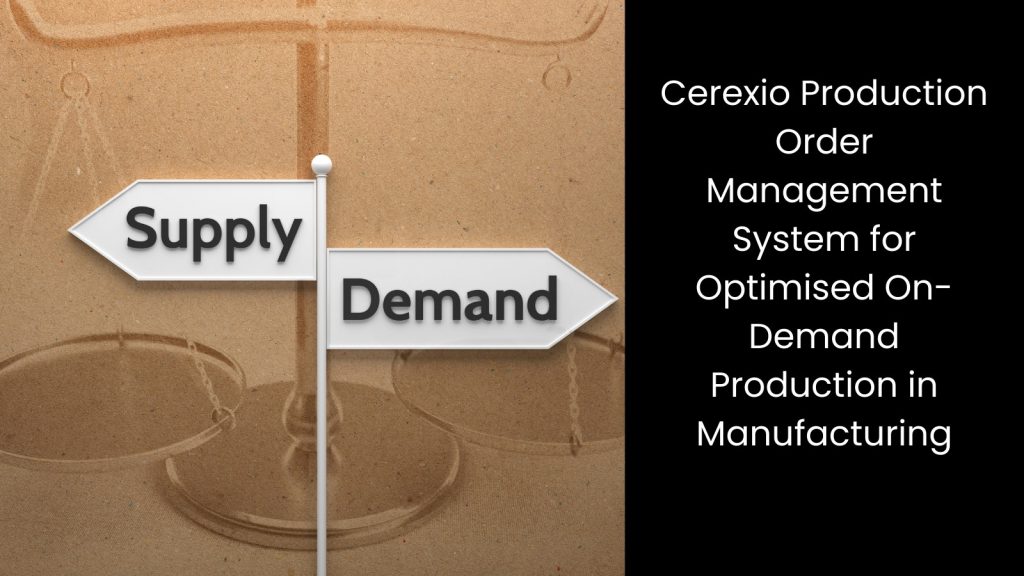It is undoubtedly a world where consumer preferences shift at lightning speed. So do the market conditions! This is why manufacturers around the world are struggling to keep up. Their main roadblock lies in those traditional mass production models, that are designed for bulk orders and long lead times. These are quickly becoming outdated. Therefore, manufacturers had to opt for something flexible. ‘On-demand production’ is a powerful strategy that allows manufacturers to produce exactly what is needed when it is needed.
In this article, we will find out whether ‘On-demand production’ is the solution manufacturers need to stay ahead in today’s competitive market.
We will look into
What is On-Demand Production in Manufacturing?

- On-demand production in manufacturing means making products only when needed instead of producing large batches in advance.
- This approach cuts down on excess inventory, storage costs, and waste, making it more efficient than traditional mass production. Unlike conventional methods, which rely on forecasting demand and bulk manufacturing, on-demand production responds directly to customer orders, keeping operations flexible and adaptable.
- Nowadays most manufacturers choose this method because it helps them avoid overproduction, reduces financial risks, and improves supply chain efficiency. The ability to customise products quickly, reduce material waste, and shorten delivery times makes this approach stand out. With this in place, manufacturing businesses no longer have to store unsold items, which improves cash flow and lowers unnecessary expenses.
- This strategy ensures efficiency, cost-effectiveness, and greater customer satisfaction in a rapidly evolving industry.
Key Advantages of On-Demand Production in Manufacturing

Lower Waste & Sustainability
Waste is a major concern in batch production that modern manufacturers usually encounter, especially when demand predictions go wrong and excess stockpiles up.
On-demand production solves this issue by making only what customers need, eliminating leftover materials and unsold inventory. Instead of producing in bulk and risking surplus, manufacturers create products based on real-time orders, ensuring resources get used efficiently. This approach not only cuts down on raw material waste but also reduces energy consumption since machines run only when necessary.
On the other hand, sustainable manufacturing benefits greatly from this model, as companies avoid dumping unused products, which lowers environmental harm.
As industries focus more on sustainability, this production method keeps waste low and ensures manufacturers meet environmental goals without overproducing. The shift towards on-demand production makes waste reduction a normal part of manufacturing, leading to a cleaner, smarter, and more resource-conscious future.
Reduced Inventory Costs
Why do manufacturers spend resources blindly when they can produce exactly what customers need without stacking up unnecessary stock?
It is indeed great news that on-demand production eliminates the headache of overflowing warehouses by making products only when orders come in. Instead of filling shelves with items that might never sell, companies keep their storage lean and costs down.
This way, warehousing expenses shrink because there is no need for massive spaces to hold unused materials or finished goods. Large-scale production often ties up money in unsold stock, but on-demand manufacturing keeps cash flow healthy by preventing overproduction. Businesses stop wasting money on maintaining facilities just to hold inventory that might sit for months.
The ability to produce on-demand means manufacturers no longer have to worry about markdowns, outdated stock, or wasteful disposal methods. With this in hand, manufacturing supply chains operate more smoothly because every unit produced already has a buyer, cutting out the risk of excess supply.
So, yes, this means less storage, fewer expenses, and a streamlined approach, all combined as one strategy.
Lower Production Costs for Small Batches
There is no need for manufacturers to spend massive amounts on bulk production when they can produce small batches without breaking the bank.
This is what exactly occurs when there is on-demand production. It removes the pressure of making huge quantities just to keep costs low, allowing businesses to create exactly what they need without wasting resources.
If you are in the manufacturing scene, you know that traditional manufacturing forces companies to invest in large orders to get reasonable pricing, but that leads to overproduction, storage headaches, and wasted materials. This is where small-batch production becomes cost-effective with on-demand manufacturing because advanced technology, like CNC machining and 3D printing, allows flexible, precise production without high setup costs.
Manufacturers no longer have to choose between affordability and efficiency since producing in smaller volumes eliminates financial risks tied to unsold inventory. The ability to make products as needed ensures companies keep cash flow steady while avoiding bulk orders that could lead to excess stock.
Minimised Risk of Obsolescence
Manufacturers do not need to gamble on large production runs when they can make exactly what sells without worrying about outdated stock. When it comes to on-demand production, it stops businesses from overproducing items that might lose value before reaching customers.
In industries where trends shift rapidly, like electronics and fashion, producing too much at once leads to warehouses full of outdated inventory. Instead of throwing money at products that may never sell, companies create small batches based on real-time demand, keeping stock fresh and relevant.
Traditional bulk production leaves businesses stuck with obsolete goods, forcing them into discounting or disposal, which drains profits. Surpassing such limitations, on-demand manufacturing eliminates that problem by keeping production flexible and adaptable. This way, companies avoid wasting materials on items that might become irrelevant, making smarter use of resources and reducing financial losses.
The best part is that this model keeps inventory fresh, reduces waste, and ensures that every product made has a purpose, helping businesses stay profitable while adapting to industry changes effortlessly.
Scalability & Flexibility
Demand is not something that stays solid, and manufacturers who stick to rigid production plans tend to struggle when orders spike or drop unexpectedly. The latter removes that problem by allowing businesses to scale production up or down based on real-time needs. Instead of locking into massive production runs that might not sell, manufacturers can create products only when required, ensuring flexibility in changing markets.
Problem with the typical manufacturing is it forces manufacturing companies to predict future sales, and this would lead to excess stock or shortages. However, on-demand production responds instantly to actual demand.
Businesses no longer need to worry about overproducing and wasting resources or underproducing and losing customers. This approach also gives manufacturers the freedom to test new products without committing to large volumes, making innovation easier and reducing risks. When demand surges, production scales up smoothly without delays, and when orders slow down, manufacturers avoid unnecessary costs by reducing output.
This flexible system keeps businesses efficient, prevents financial strain, and ensures that resources are used wisely.
Cerexio Production Order Management System for Optimised On-Demand Production in Manufacturing

Cerexio has developed a robust Production Order Management System that has the power to streamline on-demand manufacturing. Our solution is enriched with the ability to centralise orders, inventory, and data through IoT integration. With Cerexio solution, manufacturers can enhance visibility and efficiency, to produce items as needed, reducing waste and storage costs.
Levelling Up On-Demand Production with Right Technologies

No need to say that with the right technologies, on-demand production transforms into a seamless, efficient, and waste-free process. Businesses gain full control over scaling production, optimising inventory, and responding instantly to market needs. As it is evident, the key lies in the right technologies that make manufacturing faster, more precise, and endlessly adaptable in an unpredictable world.
